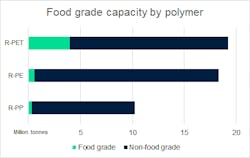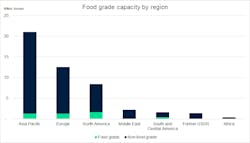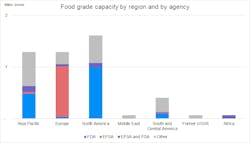Food Grade Recycled Resins are Required to Reach Global Industry Targets
Countries have their own local agencies that, among other responsibilities, control and supervise materials used in contact with food. Two central agencies widely recognized are the United States Food and Drug Administration (FDA) and the European Food Safety Authority (EFSA). Their main safety concerns are related to possible contaminants from post-consumer waste that can be harmful to human health if not removed from the packaging that will be in contact with food. Any material, including virgin polymers, must be regulated for food contact use, thus the same principle applies to recyclates.
Companies that wish to use recycled plastic for a food-contact application in the United States must submit a description of both the waste source and the recycling process, results of tests that prove the process removes potential contaminants, and a proposal of use conditions in the final application such as temperature, type of food, and duration of the contact. Full guidance is published on the FDA’s website.
Once submitted, the FDA then evaluates each proposal, case-by-case, and provides companies with a Letter of No Objection (LNO), which is a recommendation as to whether the recycling process is likely to produce plastic that is appropriate for food-contact purposes.
The EFSA evaluation of recycling processes requires companies to prepare a dossier along with a request for authorization of the use of recycled plastics in food contact materials to one of the EU Member States’ (MS) competent authorities. EFSA receives the dossier from the EU MS, evaluates it, and then provides an opinion on the safety of recycled plastic based on its intended use. The EFSA opinion is then used by the EU MS to grant or reject authorization of the recycled plastic.
The dossier must follow an EFSA guidance which includes a description of the recycling process showing critical parameters such as temperature, pressure, process duration, other operative details, and the characterization of input focusing on qualification and evaluation of suppliers, the origin of the feedstock, traceability, and the ability to prevent the entry of non-suitable materials into the input stream. Also included are the results of challenge tests to demonstrate the decontamination efficiency of the recycling process, characterization of the end recycled plastic product, its intended application in food contact, and compliance with relevant provisions on food contact materials.
“Apart from evaluating whether the recycling process can reduce contaminants to levels that do not pose a risk to human health, EFSA also monitors whether the material changes the food composition, taste, and odor in an unacceptable way. And unlike the FDA, EFSA requires that no more than 5% of the plastic waste input used for recycling comes from non-food contact applications,” said Carolina Perujo Holland, ICIS Plastic Recycling Analyst, EMEA.
Food grade resins currently represent only 10% of the global annual capacity of recycled polymers of over 45 million tonnes, according to ICIS Mechanical Recycling Supply Tracker. The research includes recycled polyethylene terephthalate (R-PET), recycled polyethylene (R-PE), and recycled polypropylene (R-PP).
However, the food-grade availability varies extensively among the resins, as represented in the following chart. Slightly over 20% of R-PET capacity globally is food grade in comparison with only 3% of polyolefins.
This difference is a result of the usage of each polymer in different applications, where PET resin is used predominantly in food packaging compared to other polymers thereby increasing the available post-consumer sourced feedstocks for recycling back into the food-grade recycled polymer. In addition, some countries currently allow the use of recycled plastics in food contact applications but many others do not, and this can vary by polymer also. This is the case in Brazil, where the National Health Surveillance Agency (ANVISA) only authorizes food grades for R-PET.
There is no country-specific regulation to explicitly allow or prohibit the use of recycled plastics in food applications in Asia except for Japan, hence the lack of any regional agency equivalent to FDA and EFSA. However, recent developments in Korea, China, and Thailand indicate food packaging applications using recycled materials may emerge.
Korea’s Ministry of Food and Drug Safety revised legislation allowing the use of R-PET and polyethylene naphthalate (R-PEN) in food contact materials as part of multi-layer structures. Thailand’s Food and Drug Administration is considering permitting the use of R-PET and R-HDPE for food contact applications. China’s National Center for Food Safety Risk Assessment (CFSA) agency is initiating a risk assessment method for recycled food contact materials.
“Although the EU has set recycled content targets under the Single-Use Plastic (SUP) Directive which is one of the main factors driving demand for recycled plastics in the region, many EU countries have not always encouraged the use of food-grade recycled plastic in food contact applications. Italy only approved the use of more than 50% non-virgin material in PET plastic bottles in 2020," added Perujo Holland.
Historically, the European food-grade recycled polyolefin market has had difficulty in growing because the level of investment was not seen to carry sufficient returns. The UK is the only successful example of food-grade recycled HDPE with EFSA positive opinion due to the discrete waste collection stream for post-consumer HDPE milk bottles used as its feedstock. The remaining EFSA positive opinions for food-grade recycled polyolefins are for closed-loop processing PP and HDPE transit packaging.
From the regional perspective, although the Asia Pacific is the largest producer of recycled resins alone, accounting for almost 45% of the global capacity, the region’s food-grade resins only represent nearly 5% of the region’s total recycling capacity, while the United States and Europe have a share of 20% and 10%, respectively.
Reasons behind that include the fact that the largest recycling end market in Asia is fiber, which is not required to be food grade. In Europe, for instance, sheet and food contact bottles are the largest end markets using R-PET from PCR bottles, with a share of the total R-PET supply of 38% and 32%, respectively, in 2019. In the United States, food contact bottles have been gaining space in the market supply of R-PET, growing from a 21% share in 2018 to 28% in 2019, while fiber reduced from 47 to 41% year over year.
FDA LNOs and EFSA positive opinions are internationally recognized high standards for food contact plastic recycled material throughout the industry and allow companies with these accreditations outside the US and EU to potentially trade with them.
FDA is the largest agency alone with almost 35% of the global registered recycling food-grade capacity whereas EFSA represents slightly over 20%. While EFSA is more prevalent in Europe, FDA is more widely used internationally, as represented in the following graph. One of the main reasons for that is the fact that the process, including traceability of feedstocks to meet the 95% food contact origin source, to obtain an EFSA positive opinion is challenging for some suppliers and is not a requirement of the FDA.
End markets for packaging with recycled content are driven, among others, by brand owners, regulation, industry associations, and consumers.
The EU has mandated the industry to include 25% recycled content in PET bottles by 2025 and 30% in all plastic bottles by 2030 under the Single-Use Plastics (SUP) Directive. Likewise, in California, manufacturers are required to include an annual average of 15% of post-consumer recycled plastic (PCR) in beverage containers starting in 2022. By 2025 the mandate is set to increase to 25% and by 2030 to 50%. Also, Washington state has recently announced a schedule for PCR requirements for different product categories, starting with beverage containers and trash bags in 2023, adding certain household cleaning and personal care products in 2025, and expanding to dairy milk containers in 2028.
In addition to legislation, several brand owners have been setting voluntary targets following the lead of the Ellen MacArthur Foundation Global Commitment which aims to have 25% of post-consumer recycled content in plastic packaging by 2025. Many global PET beverage bottle brands have even set sustainability targets beyond those required, averaging at 50% R-PET by 2025 in Europe. Even extending to 100% R-PET content in some European markets in timeframes earlier than 2025. In order to fulfill their targets, companies need to source recycled resins and applications such as beverage containers and primary food packaging, which require high-quality food-grade recycled resins, which are currently limited. Investment is needed in collection systems, consumer education, and recycling capabilities in order to increase the global supply of recyclates to reach industry targets.
In the long term, chemical recycling can be a potential complementary solution to mechanical recycling to secure a supply of recycled resins suitable for food contact applications. The industry has high expectations for the higher volumes of feedstock that chemical recycling can process, in addition to its source, as any waste stream can potentially be used, including films and flexible packaging. Recycled resins produced through chemical recycling have near-identical properties to virgin and as such are not subject to food-contact regulation restrictions.
However, despite current investments in chemical recycling facilities, ICIS expects that industrial-scale may not be achieved before the 2030 deadlines for mandates and sustainability-related pledges. Moreover, the magnitude of its environmental impact, as well as its legal status, are unclear.
In conclusion, immediate measures are needed to improve collection rates and sorted fractions while reducing contamination in the recycling stream, in addition to mid and long-term solutions, such as regulations and technologies. Including a review of the criteria around the food safety regulations, such as the 95% feedstock origin, which presents more challenges for polymers that have lower concentrations of food contact material from origin in their overall waste stream.













